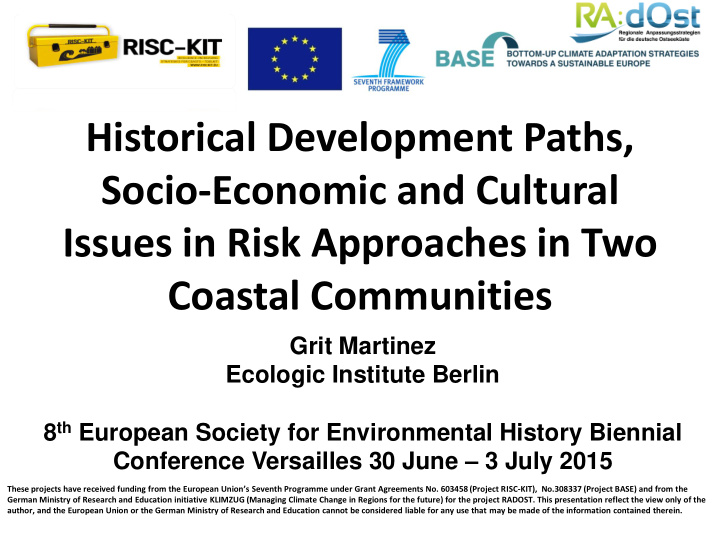



Historical Development Paths, Socio-Economic and Cultural Issues in Risk Approaches in Two Coastal Communities Grit Martinez Ecologic Institute Berlin 8 th European Society for Environmental History Biennial Conference Versailles 30 June – 3 July 2015 These projects have received funding from the European Union’s Seventh Programme under Grant Agreements No. 603458 (Project R ISC-KIT), No.308337 (Project BASE) and from the German Ministry of Research and Education initiative KLIMZUG (Managing Climate Change in Regions for the future) for the project RADOST. This presentation reflect the view only of the author, and the European Union or the German Ministry of Research and Education cannot be considered liable for any use that may be made of the information contained therein.
Content I. Framework of the Research II. ‘Total Ecology’ and risk approaches III. Influence of History on Risk Approaches: Contrasting Example from Two Coastal Communities 2
Framework of the Research 2008 German Strategy for Adaptation to Climate Change (DAS) adopted 2011 Action Plan for Adaptation of the German Strategy for Adapting to Climate Change: “Municipalities are among the central actors of adaptation to climate change. Many consequences of climate change manifest themselves locally, and many adaptation measures need to be developed and implemented together with local communities. ” 3
Risk approaches are about people & places and their history & culture ‘Total Ecology’: Source: Mike Orbach, Duke University/ Nicholas School of the Environment (unpublished) 4
Study region: Two communities at the southern Baltic Sea Coast in Germany (distance 300 km) Ummanz Timmendorfer Strand
Comparable bio-physical conditions/ vulnerablity ( 3m above SL, identical exposure to storm surges/ SLR/ bathtube effect) Similar SSL projections Ummanz Identical experiences with historic storm floods (1872): Equivalent reconstruction aid Timmendorfer Strand out of the funds of the German empire Risk of flooding – historic records -Storm surge levels (SSL) higher than 3,0 m above Mean Water = one event -SSL higher than 2,0 m above Mean Water = rare -SSL higher than 1,5 m above Mean Water = infrequent -Storm surge levels higher than 1,2 m above Mean Water = frequent
Methods 17 Semi-standardised narrative interviews (2012/2013 average duration: 2- 3 hours) with residents (village chronicles, heads of regional and “ Heimat ” (homeland) associations, local decision-makers, entrepreneurs. Complemented by 30 interviews with passers-by (standardised questionnaire ) at central locations in both communities . Background research: village chronicles, diaries, local novels/ photographies … 7
Development paths after the 1872 storm flood Timmendorfer Strand (Schleswig-Holstein) after the highest previously known flood in November 1872; Source: Herde:2002 Explanation about the errection of a dyke in 1872 Historic storm mark in Dahme (Schleswig-Holstein), 1873 („Der Wall“) in the chronicle of Ummanz Source: Eckert: 1992 (Mecklenburg -Pommerania), Source: Mursewiek: 1947)
Further separations after WW II Timmendorfer Strand: “The Baltic, the beach and the coast are our life blood, this is our capital” 6 km of coastline 200.000 tourists p.a. (1.2 Mio overnight stays p.a.) 4.500 inhabitants, many second home owners from the nearby city of Hamburg
Further separations after WW II Ummanz „A nice quiet corner which many like to visit… Guests keep saying that we should be careful that nobody destroys this for us…” Scattered farms Sparsly populated ( 600 inhabitants, several thousand visitors p.a.) Mainly wet meadow and marsh land next to Laggon National Park Preservation of agricultural land reclaimed from the sea - which is partly a material but mostly an immaterial value – is very important 10
Key messages Historical natural events, socio-economic developments and cultural values drive risk perception, response and preparedness to environmental challenges. Historical development paths lead to particular material and immaterial value sets which find expression in differing views of “Heimat” (“Homeland”). These lead to different demands placed e.g. on coastal protection and adaptation measures. Risk management strategies need to be anchored in development traditions. Reference is necessary to local interests, values and attitudes – in this case to the coast and sea. More empirical investigations on the history of human and institutional ecology/ understanding the underlying reasons why communities or regions are vulnerable and why they act they way they do are needed in the policy arena.
Recommend
More recommend